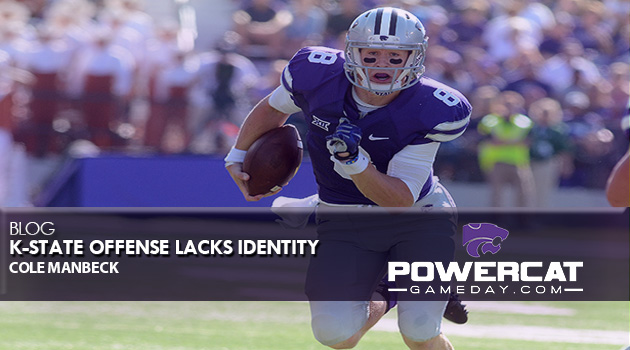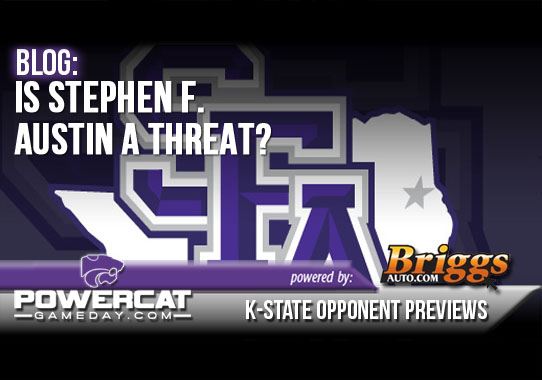K-State’s Offense Lacks an Identity
By Cole Manbeck
I’ve picked on Kansas State’s offense in the majority of our blog posts this season. The defense deserves just as much criticism, so to be fair, we will have two posts this week – one on the offense and another on the defense. For the purposes of consistency, this blog post will focus on the offense. Later in the week, we’ll have a blog on K-State’s defensive struggles.
I’d like to begin with a question: what is K-State’s offensive identity? It’s a hard question to answer, because the Wildcats don’t seem to have one. I thought they discovered their identity against TCU when they gashed the Horned Frogs with the running game in the first half. Then, they abandoned the ground attack in the second half of that game, and it once again went missing the following week against Oklahoma. Less than two weeks ago, I thought K-State rediscovered its identity, when it ran the ball 48 times for 258 yards, an average of 5.4 yards per rush. It was the best rushing performance against the Baylor defense all season – a unit that was only allowing 3.5 yards per rush. It was a great game plan.
Nine days later, the Wildcats traveled to Texas Tech to face a Red Raiders defense that was allowing 5.7 yards per rush against FBS opponents, ranking 123rd out of 128 FBS teams in yards-per-carry defense. In the previous four meetings against Tech, K-State averaged 230 rushing yards per game and 5.2 yards per carry. Entering Saturday, eight of Tech’s 10 opponents this season had run for at least 225 yards against its defense.
K-State has proven it can be effective in the run game during Big 12 play. The passing game? Not so much. The Wildcats are arguably the worst passing team in the Big 12. K-State is 107th nationally and last in the league in pass efficiency offense. The Wildcats are 121st in the country and last in the Big 12 in completion percentage. And they are 91st nationally and 8th in the conference in yards per pass attempt.
Knowing these numbers, I expected K-State to go to Lubbock with the mindset to run the ball, especially considering the fact that if you can run the ball so effectively against a good Baylor run defense, you can certainly do so against the Red Raiders. The counter argument is Tech knew K-State would want to run the ball and did everything it could to take it away. My counter to that is everybody wants to run the ball against Tech. The Red Raiders allowed 5.4 yards per rush last season, ranking 115th nationally. Stopping the run has been an ongoing problem for the Red Raiders for quite some time. I admittedly haven’t watched every Tech game on film dating back to the beginning of the 2014 season, but I’m going to guess that Saturday’s game against K-State wasn’t the first time Tech’s defensive coaches tried to stack the box to take away the run. And presuming that’s the case, the Red Raiders have rarely stopped it with that approach.
However, K-State only ran the ball 34 times against the Red Raiders. That number includes quarterback scrambles on designed pass plays as well as sacks. That’s the fewest rushing attempts against Tech this season. Only one other team has run the ball less than 40 times in a game against the Red Raiders this season, and that team was Oklahoma State. And that’s logical, because the Cowboys are terrible at running the ball, ranking 98th nationally and 9th in the Big 12 with just 3.7 yards per carry. Their strength is passing, where they rank No. 9 nationally in passing efficiency and 8th nationally in yards per pass attempt. So their 36 rushing attempts against the Red Raiders made sense.
K-State’s 34 rushing attempts Saturday were illogical. Yes, K-State was playing from behind, thus increasing the passing attempts. However, K-State ran seven designed pass plays on its first nine offensive snaps, so the game plan didn’t appear to be run-heavy from the get-go. And had the Wildcats showed a determination to run the ball from the outset of the game, I’m not certain they would have been playing from behind the entirety of the game.
K-State attempted a pass on 55 percent of its offensive plays Saturday, tying KU for the highest pass percentage attempts against the Red Raiders defense this season. On the season, Tech’s FBS opponents attempted passes on only 42 percent of its offensive snaps, running the ball 58 percent of the time. K-State, the worst passing team in the league, attempted to run the ball 13 percent less than the season average against Tech. See the below table for a game-by-game comparison of each of Tech’s opponents when running the ball this season.
Texas Tech opponents’ run-play percentages and running plays overall in games in 2015
| Opponent | Rushing play % | Running Plays Overall | Yards per rush/total rushing yards |
| Sam Houston State | 47% | 46 | 6.9/317 |
| UTEP | 60% | 46 | 4.9/227 |
| Arkansas | 67% | 43 | 5.3/228 |
| TCU | 46% | 47 | 5.3/247 |
| Baylor | 68% | 52 | 7.1/368 |
| Iowa State | 60% | 45 | 7.0/315 |
| KU | 45% | 40 | 3.6/145 |
| Oklahoma | 72% | 57 | 7.1/405 |
| Oklahoma State | 46% | 36 | 5.1/184 |
| West Virginia | 70% | 57 | 5.3/300 |
| K-State | 45% | 34 | 3.6/123 |
As you’ll see on the above chart, K-State wasn’t great running the ball, averaging 3.6 yards per carry. Please note that number looks worse than it actually is due to a handful of runs on the goal line as well as two sacks.
At this point of the blog, you might think it seems strange to complain about a unit that scored 44 points in a game. And I agree with you. But K-State was very average offensively. The best way to judge an offense is points per offensive possession and yards per play. The Wildcats averaged 5.4 yards per play Saturday, tying for the second-lowest average from a Tech opponent this season. The Wildcats averaged 2.7 points per possession, which is OK but not great (see the table at the end of this blog for a detailed game-by-game breakdown). K-State had nine offensive possessions where it didn’t score. That’s far too many against one of the worst defenses in college football. K-State punted seven times, tying UTEP for the most punts in a game against Tech this season. Did the lack of commitment to running the ball cost K-State Saturday? I can’t say that for certain. But it did put the Wildcats in a less than advantageous situation (as did the defense, obviously).
“We’ve got to be able to throw the ball, and have balance in our offense to become a productive offensive football team,” K-State head coach Bill Snyder said following the loss Saturday.
Balance is ideal. As an obvious disclaimer, Snyder knows way more than I do. I can’t state that enough. But having balance just for the sake of being balanced isn’t effective if the passing game is a significant weakness, which it has proven to be this season. K-State has shown it doesn’t have to be balanced to win games on occasion in the past. In 2010, K-State ran the ball 50 times and had just four passing attempts against Texas. The Wildcats won 39-14. In 2013 at Tech, K-State threw the ball just 11 times, running it on 45 attempts. The Wildcats won 49-26. Just because an opponent might know the run is coming doesn’t mean it will stop it.
Instead of making an effort to be balanced, the Wildcats need to commit to their strength, which is running the football. They need to establish their identity. And they’ve got three games left to do so.
How opponents have fared against Texas Tech’s defense in 2015. K-State’s effort Saturday produced the second-lowest yards-per-play average vs. the Red Raiders this season. The Wildcats’ 45-percent completion percentage was the worst against Tech this season, as were K-State’s 412 yards of total offense.
| Opponent | Yards per play | Total yards | Completion % | Points per possession |
| Sam Houston St. | 6.5 | 637 | 69 | 2.8 |
| UTEP | 5.4 | 414 | 61 | 1.4 |
| Arkansas | 6.6 | 424 | 76 | 3.0 |
| TCU | 7.3 | 750 | 63 | 3.9 |
| Baylor | 8.9 | 680 | 67 | 4.2 |
| Iowa State | 6.6 | 495 | 50 | 2.2 |
| KU | 5.3 | 475 | 70 | 1.3 |
| Oklahoma | 7.8 | 617 | 68 | 4.8 |
| Oklahoma St. | 8.4 | 662 | 63 | 4.2 |
| West Virginia | 5.5 | 449 | 50 | 2.6 |
| K-State | 5.4 | 412 | 45 | 2.7 |




